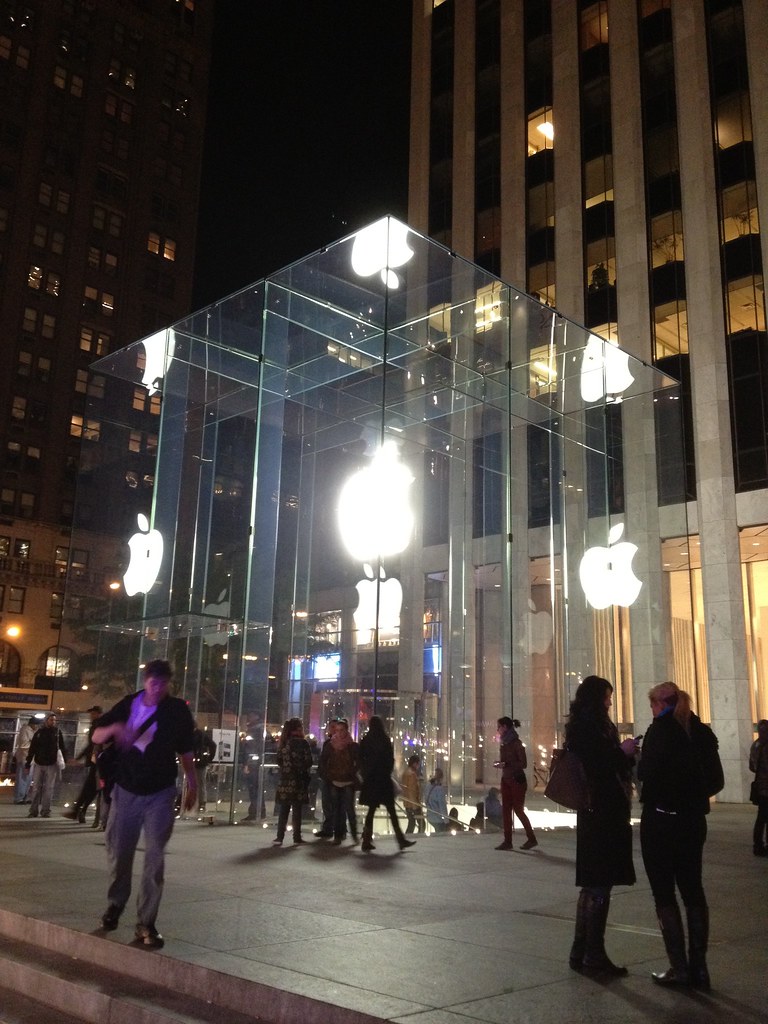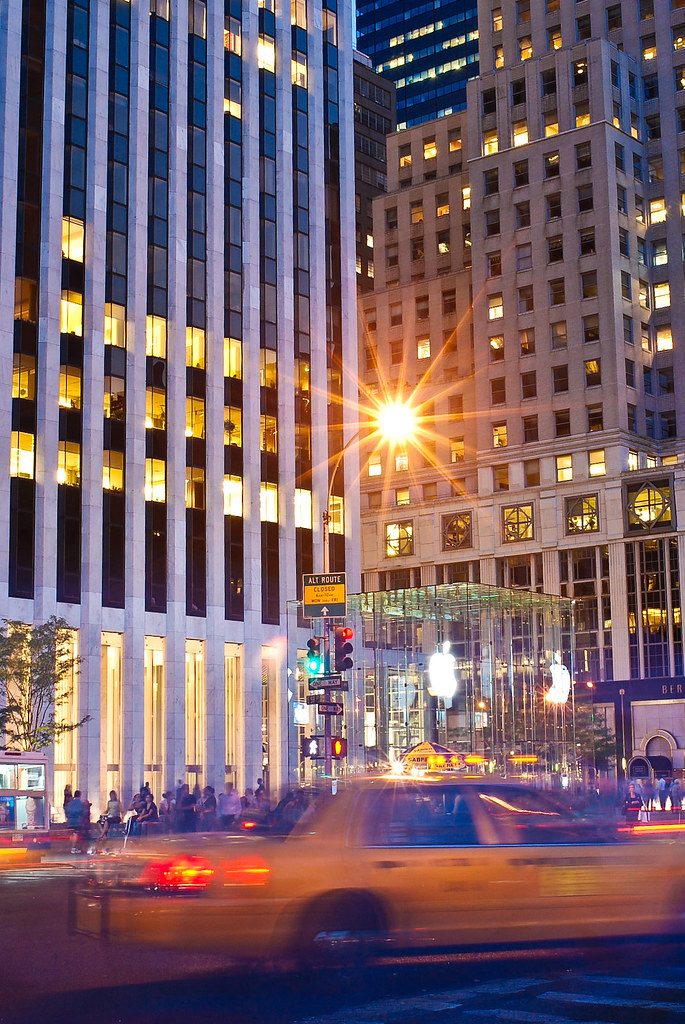|
|
General: The glass cube entrance to the Apple Store on Fifth Avenue, Manhattan, New York,
Choisir un autre rubrique de messages |
|
Réponse |
Message 1 de 25 de ce thème |
|
|
|
|
|
Réponse |
Message 2 de 25 de ce thème |
|
Apple's New Fifth Avenue Store Cube Fully Revealed
By Eric Slivka
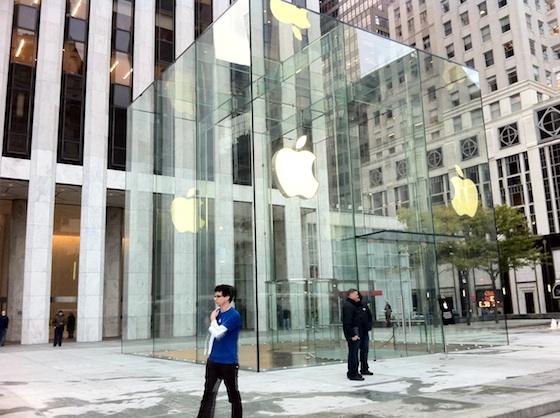
While Apple's Fifth Avenue retail store in Manhattan is not set to reopen until 10:00 AM this morning, crews have completed their work on the revamped glass cube, fully revealing the streamlined design for the first time.
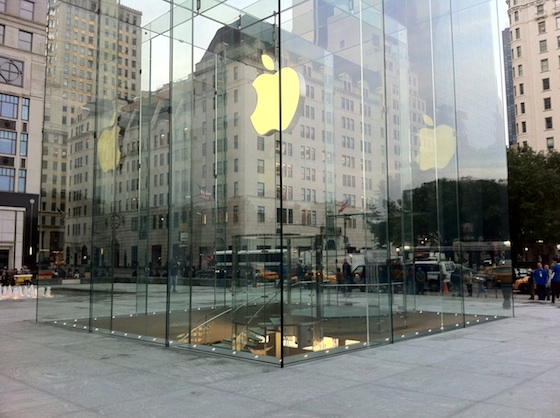
MacRumors reader Vincent sent along these photos of the new cube, which utilizes only 15 panes of glass rather than the 90 used in the original cube. The new cube is also "seamless", doing away with nearly all of the hardware that previously held the panes of glass together.
In addition to the new cube, Apple has also upgraded the plaza, refreshing or installing new water drains and pavers while removing the small bollards that had previously surrounded the cube.
Update: YouTube user patjem2 has posted a brief video showing the new cube and a growing crowd of customers just prior to the store's reopening.
A second video also shows the first customers entering the newly-reopened store through the updated glass cube.
Copyright © 2000-2011 MacRumors.com, LLC.
November 4th, 2011, 01:44 PM#274
Fearless Photog

Looks like they also ditched the depression from when, I think, this was a third fountain.
November 9th, 2011, 01:58 PM#275
|
|
|
|
Réponse |
Message 3 de 25 de ce thème |
|
|
|
|
Réponse |
Message 4 de 25 de ce thème |
|
Apple's "Mecca Project" Provokes Muslim Reaction On October 10, 2006, an Islamic website posted a message alerting Muslims to what it claims is a new insult to Islam. According to the message, the cube-shaped building which is being constructed in New York City, on Fifth Avenue between 58th and 59th Streets in midtown Manhattan, is clearly meant to provoke Muslims. The fact that the building resembles the Ka'ba (see picture below), is called "Apple Mecca," is intended to be open 24 hours a day like the Ka'ba, and moreover, contains bars selling alcoholic beverages, constitutes a blatant insult to Islam. The message urges Muslims to spread this alert, in hope that "Muslims will be able to stop the project." 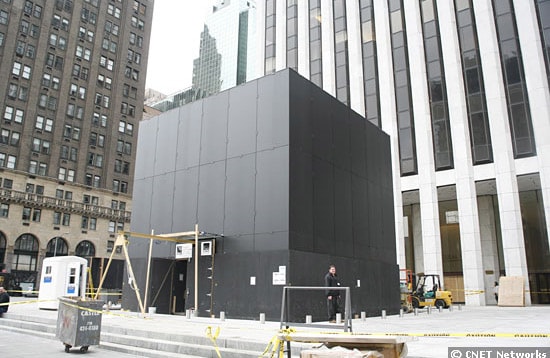 http://memri.org/bin/latestnews.cgi?ID=SD131506 http://memri.org/bin/latestnews.cgi?ID=SD131506
|
|
|
|
Réponse |
Message 5 de 25 de ce thème |
|
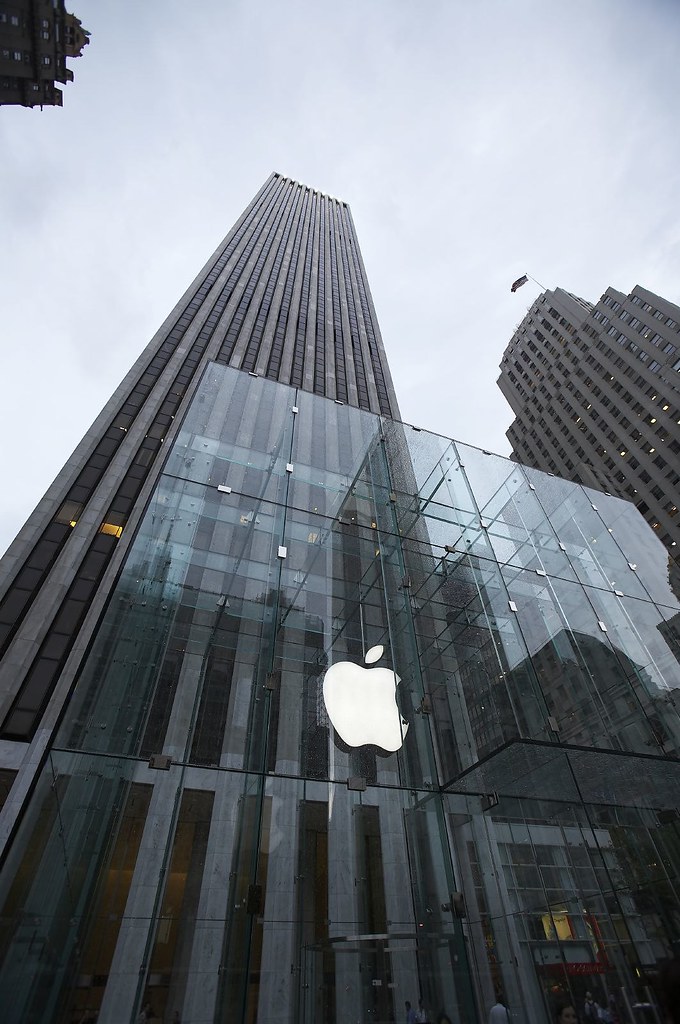 The Sailer Man on Flickr: The Sailer Man on Flickr: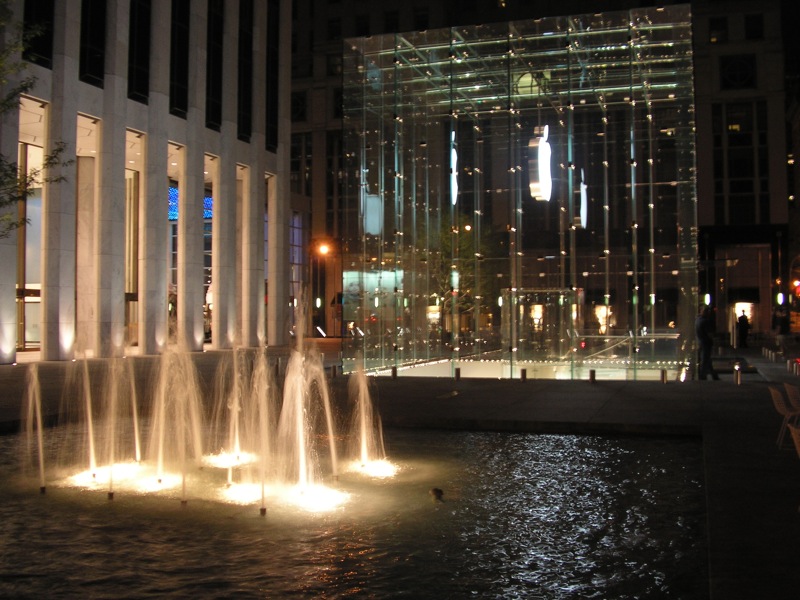 |
|
|
|
Réponse |
Message 6 de 25 de ce thème |
|
 Lyndon Wong on FlickrJanuary 7, 2007 Lyndon Wong on FlickrJanuary 7, 2007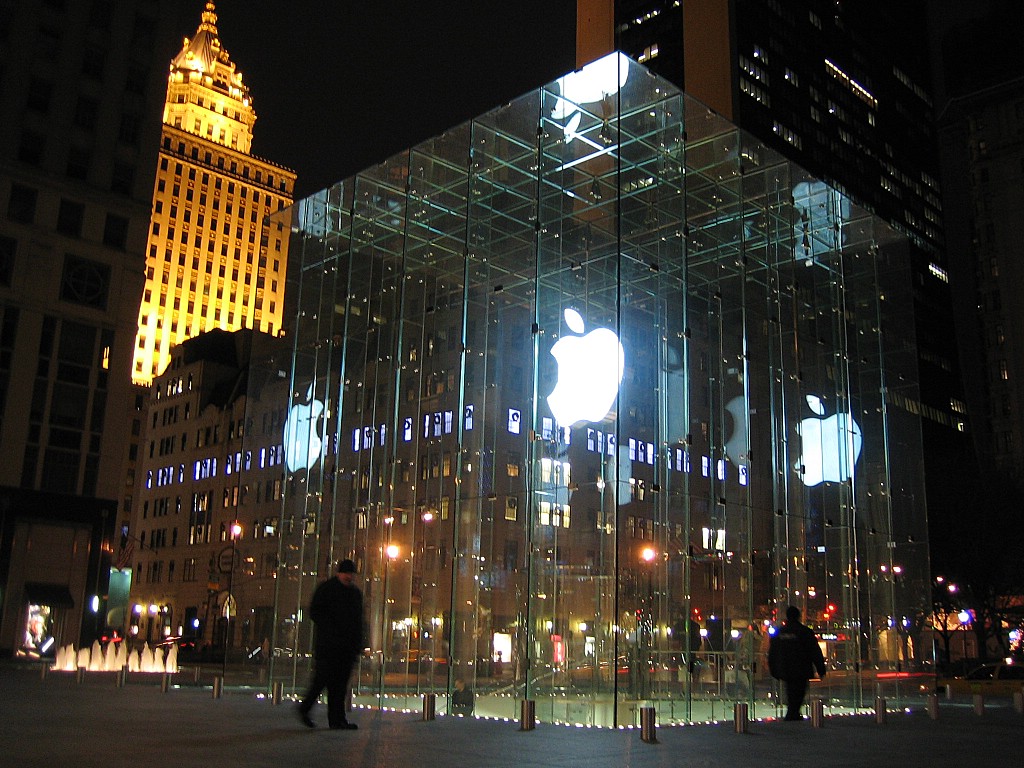 |
|
|
|
Réponse |
Message 7 de 25 de ce thème |
|
|
|
|
Réponse |
Message 8 de 25 de ce thème |
|
|
|
|
Réponse |
Message 9 de 25 de ce thème |
|
 Many Highways was up in Midtown yesterday and snapped a few pictures of the new cube. Is it just us, or does that black granite look positively evil? Wasn't it supposed to be made out of clear glass? Or is the real cube inside the black wrapping? Mac architecture nerds, please let us know. Many Highways was up in Midtown yesterday and snapped a few pictures of the new cube. Is it just us, or does that black granite look positively evil? Wasn't it supposed to be made out of clear glass? Or is the real cube inside the black wrapping? Mac architecture nerds, please let us know. |
|
|
|
Réponse |
Message 10 de 25 de ce thème |
|
New York's Future, Cubed
New York Sun Editorial
When the new Apple Store opens for its press preview today in front of the General Motors building, the story will be about more than a major marketing move by Apple. The giant box that will be unwrapped marks a new chapter in the story of New York, how the city renews itself, takes entrepreneurial gambles, marshals private capital to remake one of its most important public squares, and creates a sense of style and optimism about the future.
The Apple Store itself will be below street level, but its entrance will be marked by a glass cube measuring 32 feet along each side, a structure that promises to make the plaza at long last the iconic public space it has long striven to be. The cube, which hearkens to the iconic I.M. Pei pyramid in the Louvre courtyard at Paris and looks stunning in architects' renderings, is all but guaranteed a quick admittance into the pantheon of New York landmarks.
The store will sit at one of the most dramatic intersections in the world, adjacent not only to one of the most beautiful classical commercial buildings in the city - Bergdorf's - but across Grand Army Plaza from the Plaza Hotel, itself undergoing, with private capital, a major renovation and reinvention as a combination of luxury condominiums and a smaller and even more elegant hotel. It is a bet on, among other things, the idea of world-scale retail in the heart of a modern city.
The visionary behind the site of the Apple Store is Harry Macklowe, chief executive of Macklowe Properties. No stranger to the rough and tumble of New York real estate, he has long been a lightning rod in the city, partly a consequence of leading a series of projects, like the Metropolitan Tower, that have reshaped Manhattan's skyline. Say what one will about Mr. Macklowe, however, one has to give him credit for at least one thing - he knows how to place a big bet.
The site on Fifth Avenue between 58th and 59th Streets is an example of the process of reinvention that reshapes the city. The neighborhood started developing in the mid-19th century as the city grew northward. By 1870, William "Boss" Tweed had broken ground on a hotel there. It would have been called the Knickerbocker, but the project was interrupted when Tweed's reign collapsed in 1871. In the 1890s, the site became home to the Hotel Savoy, which would stand until it was replaced, in 1927, with the Savoy-Plaza. The new hotel building, designed by McKim, Mead & White, was a social and architectural landmark for decades.
It was torn down to make way for the present GM building, which opened in 1968. At the time, demand for office space in the Plaza neighborhood was high; one New York Times article in 1967, written as the GM building was going up, described the search for office space there as being "as intense as that for secretaries with English accents." One real estate expert, Laurence Meltzer, explained the district's popularity thus: "The Grand Central area is a functional area with a good labor force. Up in the 50s they're a little more conscious of class. There's more glitter and glamour."
"Glitter and glamour" would become the watchwords of the GM building, designed by Edward Durell Stone and Emery Roth & Sons. Its white marble-and-glass facade and elegant interiors elicited awed reactions from many of the 10,000 people who streamed through its doors on opening day in September 1968. A construction worker who had helped build it, John Greaves, told the Times, "I think it's the greatest building in New York, and not just because I worked on it." "Outstanding" was the verdict of a certain deputy commander of West Point by the name of Alexander Haig.
The developers were conscious of the fact that they were building more than a skyscraper but were in fact redesigning part of the city's public landscape. They set the building's 50-story rise back from the avenues as a way to avoid making the structure too overbearing. They also conceived of the plaza on Fifth Avenue as a new public space. On opening day, a Mrs. Max Cogan of Miami Beach told the Times that "I especially like the fact that it is set back from the street. All buildings should be like that." The original plaza, the heart of which was sunk 12 feet below street level, generated less enthusiasm. It attracted less foot traffic than its planners had hoped.
The building embodied a certain tension between the prejudices of architectural elites and ordinary New Yorkers. The latter were enthusiastic about the GM building, while the former were more skeptical. The architecture critic at the Times, Ada Louise Huxtable, described the variance as "the difference between I-know-what-I-like and serious judgment of the building's form and functions, and its impact on the New York scene." A worker at the Hamburger Heaven on 56th Street, Kenneth Williams, declared that the building would become a landmark. Ms. Huxtable declared that "General Motors has brought a new style and a new kind of abundance to Fifth Avenue. It has the best address in town. It has not given the city its best building." Forty years later, one almost thinks the burger flipper, and not the esteemed critic, turned out to be right.
The GM building reflects the way in which, in New York, even the things that stay the same are always changing. When it was built, the company whose name it bears was one of the greatest in the world. Yet by the 1980s, GM optioned the building to raise $500 million in cash and finally sold it in 1991. It ultimately found its way into the hands of an insurance company, Conseco, and one of New York's most flamboyant personalities, Donald Trump. The tower appeared in headlines yet again in 2003, when it fetched the highest price ever paid for an office tower on the continent as Mr. Macklowe paid $1.4 billion for it.
Much of that deal was financed with help from foreign businesses and individuals like Deutsche Bank and George Soros, and was eventually refinanced with capital from a private firm based in Atlanta and fueled by investments from Germans. It's a suitably global financing arrangement for one of the premier office towers in a global city. At the time, people were astounded by the audacity of the move and wondered how such an investment could ever pay off. Mr. Macklowe has been busily working to prove the skeptics wrong. Just over one year after the purchase, the building was estimated to be worth $1.6 billion.
That value arises from the building's continuing ability to attract A-list tenants, from Estee Lauder to the law firm Weil Gotshal & Manges to the toy store F.A.O. Schwartz to the hedge fund Perry Capital. The site has always been a microcosm of the economy and shows how important New York remains to the national, and global, economy. The space that once housed an automobile showroom now is home to a national television studio. The fact that Apple is investing in the site shows that Silicon Valley still pays homage to New York.
Meantime, even as the property has changed hands, its successive owners have striven for the right solution to its public space. Aware that the old plaza design wasn't working, Mr. Trump filled in the 12-foot-deep pit, in part to create more retail space below ground and in part to try to create a more workable public space. The effort was only partly successful. Then again, trial and error have been part of New York life for centuries.
The third time may well prove to be the charm. The glass cube is already generating buzz, in part because of some of the eccentricities of its design process. Mr. Macklowe reportedly had a full-size mock-up erected in the plaza under cover of darkness one night so that he could envision what it would look like. Just as quickly he had the model removed before daybreak. The developers reckon the cube will be its own advertisement for the store below, as there will be no signage on it.
Whether or not the public takes a shine to the cube and the revamped plaza around it, one thing is already clear. This cube is emblematic of the city that will surround it. It caps a gamble by one of the city's most daring real estate entrepreneurs. It will represent a reimagining of another metropolis's landmark. It will mix unabashed commercialism with a sense of civic responsibility. It is a bet of one entrepreneur and his private financial backers, offering an opportunity to reflect on how private enterprise has reshaped the city for generations and no doubt will for generations to come.
http://wirednewyork.com/forum/showthread.php?t=5681&page=9
|
|
|
 Premier
Premier
 Précédent
2 a 10 de 25
Suivant
Précédent
2 a 10 de 25
Suivant Dernier
Dernier
|
|
| |
|
|
©2025 - Gabitos - Tous droits réservés | |
|
|

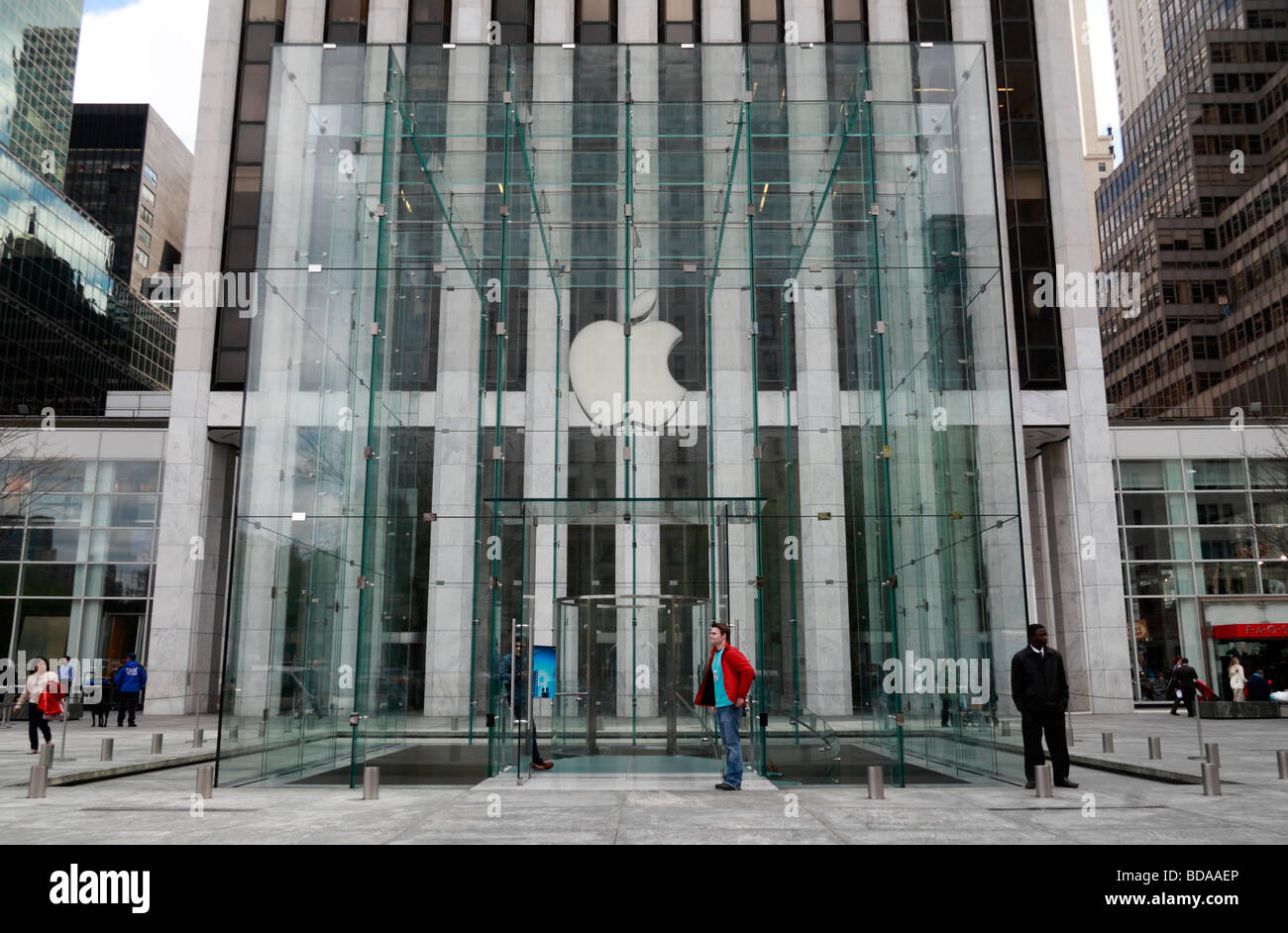


 Reply With Quote
Reply With Quote